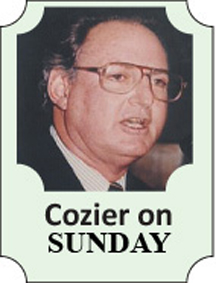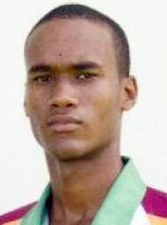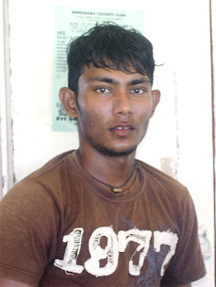Notwithstanding the results, there are hopeful signs that the long process of building a truly competitive West Indies team is gradually taking shape.
The problem is that they continue to be compromised by the inconsistency, strange strategy and self-inflicted damage that were among the reasons why they fell to their lowly status in the first place.

The lingering instability remained evident in Bangladesh, in spite of the favourable results. Two comprehensive wins in the ODIs were followed by a 61 all-out total in the third. A fight to save the first Test was transformed into victory by 229 runs in the second.
Even so, there was enough cause for general optimism.
Two fledgling openers posted a partnership of 100 in the second Test. Kirk Edwards compiled his second hundred in his third Test. Dwayne Bravo’s 195 was the belated breakthrough his obvious talent indicated would come sooner or later.
Fidel Edwards, picking up where he left off in his comeback series against India in the Caribbean, blew away the first five in the order, his eleventh return of five or more wickets in an innings. Davendra Bishoo collected his first five-for to seal the deal in the deciding Test. Carlton Baugh’s keeping was exceptional, the fielding sharp.

With Shivnarine Chanderpaul continuing to supply the middle order solidity and guidance, it seemed most areas were covered. A vulnerable lower order and uncertainty against spin on traditional sub-continental pitches remained the major concerns.
This, of course, was against Bangladesh. There would be more searching questions from the series in India.
After two Tests, both heavily, but not unexpectedly, lost, the answers have not been positive, especially since the West Indies’ woes have been much of their own making.
Indisciplined all-round cricket, the shaky lower order batting and some inexplicable tactics undermined them in both Tests.
Chanderpaul’s hundred and his partnership of 108 with the teenager Kraigg Brathwaite placed them at a promising 265 for five after the first day in Delhi. The remaining five wickets then tumbled for 48 next morning.
Even so, Baugh’s sharp work standing up to the stumps allied to spirited bowling dismissed India’s mighty batting for 209, gaining an unlikely lead of 95. A repeat of the first innings total would have set the home team 400 to win, even tough for such a formidable lineup.

It was time to tighten the squeeze. Instead, it went slack. All out 180 in the second innings presented no great challenge for the Indians who comfortably gathered the required 276 with five wickets to spare.
On to Kolkatta’s Eden Gardens – and more disappointment.
It wasn’t so much that India amassed 631 for seven declared. An order of Gambhir, Sewag, Dravid, Tendulkar, Laxman and Dhoni is accustomed to such mammoth totals – and, in this case, Tendulkar was kept one short of that keenly anticipated hundredth hundred (there is now an even greater incentive to get it in this week’s final Test in his home town, Mumbai).
This was the fifth time in the past two years the Indians had so indulged themselves. Twice since 2009 they went past 700. A year earlier, Sewag, Tendulkar, Laxman and Dhoni all helped themselves to hundreds as they thumped South Africa (Dale Steyn, Morne Morkel, Jacques Kallis et al) for 643 for six declared to win by an innings.
There were other issues to irk coach Ottis Gibson more, errors that helped India to such an onslaught.

Perhaps he could explain why, for instance, Darren Sammy chose to himself open the bowling with Fidel Edwards, in spite of the presence of Kemar Roach. The four boundaries taken off his two tame overs set India on the way.
As the television commentators, not least an upset Ian Bishop, kept stating, Edwards and Roach (when he got on) bowled repeatedly too short on a slow pitch. In contrast, India’s new, lively fast bowler, Umesh Yadav, earned his seven wickets through maintaining a full length and direct line.
Even more annoying were Roach’s two no-balls in consecutive overs that negated Baugh’s catches, allowing Dhoni to escape at 13 and 16 and proceed to plunder five sixes and 10 fours in 144 off 181 balls.
Sammy had made it a point to refer to the absence of a single extra in the 68 overs of Bangladesh’s first innings in the second Test. Now, in addition to Roach’s costly transgressions, Edwards had shattered Sewag’s stumps with a no-ball in the first Test when he was 8. Fortunately, they weren’t made to pay full price for the mistake, Sewag scoring 55.
In significant contrast, India did not send down a single no-ball in the 174.3 overs of the two West Indies innings in Kolkata (54.3 by Yadav and Ishant Sharma between them).
Overwhelmed by their two days under the hammer, the West Indies batsmen could not bring themselves to a proper first innings response.
Their all-out 153 sealed their fate. Their comeback in the follow-on confirmed the potential of the batting and restored some pride. Bravo’s second hundred in three Tests, Marlon Samuels’ highest score since his return, sixties from Adrian Barath and Kirk Edwards and Chanderpaul’s 47 even appeared to be carrying them into the lead until the late meltdown that is never far away arrived, the last six wickets for 54.
For all the problems, there is enough to suggest that elements are in place for the restoration. But it won’t happen until it is appreciated that Test cricket is still a two-innings contest.





